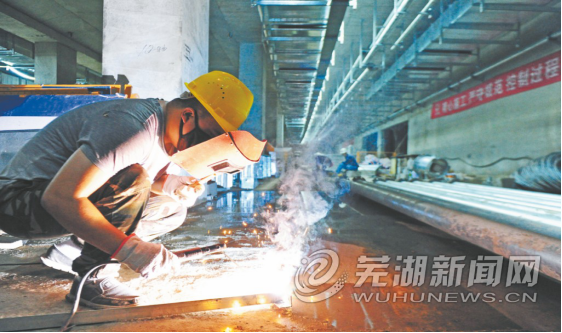HEFEI, Aug. 20 (Xinhua) — Xi Jinping, general secretary of the Communist Party of China Central Committee, has visited flood-stricken residents in east China’s Anhui Province.
While visiting Funan County in the city of Fuyang, Xi checked the water situation of the Huaihe River and learned about local measures for flood control, disaster relief and post-flood production recovery. He also visited and consoled those affected by floods.
As floods have basically receded, local farmers in Anhui have resumed farming to secure a bumper harvest in autumn, with the help of agricultural technology.
Twenty-five-year-old Xi Wei manages an 87-hectare rice farm in the city of Wuhu. Every day he rides an electric bicycle to learn the growth of rice seedlings. From time to time, he stops for a quick check on soil conditions — on his smartphone.
The farm is on the banks of the Zhanghe River, a tributary of the Yangtze River. It is a “smart” agricultural demonstration project initiated in 2018 by Zoomlion Agriculture Machinery Co., Ltd., a subsidiary of Zoomlion Heavy Industry Science & Technology Co., Ltd., one of China’s leading high-tech equipment manufacturers.
An app in his phone provides information about soil moisture and temperature. Sensors in the fields monitor the soil conditions around the clock and relay the readings to him via WiFi.
Xi Wei just checked the moisture of the soil in the paddy fields.
“It is necessary to drain all the water in the fields so that the permeability of soil can be increased, and the roots of the seedlings can grow deeper,” he said.
Since the launch of the project, the company has installed many high-tech devices in the fields, such as soil sensors and insect-monitoring lamps. The data collected by these devices will be transmitted simultaneously by the Internet of Things (IoT) to smartphones and computers.
Despite the rare floods since mid-June, the rice seedlings in the fields have not been affected much because of the equipment embedded here.
“The information-driven rice planting is the primary feature of our fields. Meteorological stations, soil sensors, insect-monitoring lamps, and the IoT are cutting-edge tools we use to cope with natural disasters and mitigate losses,” said Xi Wei.
The project also uses satellite navigation technology to level the fields to increase yield of rice.
“With the help of the global navigation satellite system, the machine levels the fields with an average error of less than 3 cm for each patch,” said Xi Wei, adding that the result was impossible for the traditional farming machines.
With constantly improving flood prevention systems, water conservancy infrastructure and mechanization over the past few years, major grain producers in China have upgraded their capabilities in countering natural disasters.
China attaches great importance to food security. President Xi Jinping has spoken of the issue on many occasions. Grain production, with farmland as the fundamental element, is supported by water conservancy systems, facilitated by science and technology, and driven forward by policies. Issues relating to these key points must be addressed earnestly and properly to attain breakthroughs in grain production, he has said.
China issued a guideline regarding advancing the development of agricultural high-tech industry demonstration zones in 2018, highlighting the importance of technology in modernizing agriculture and the role of demonstration zones in spearheading the efforts.
The country has been promoting key technologies in agriculture, such as high-yield hybrid rice varieties developed by Yuan Longping, the “father of hybrid rice,” and the wide use of smart farming machinery.
The application of agricultural science and technology has played a positive role in increasing grain output. In 2018, the contribution of scientific and technological progress to agriculture reached 58.3 percent, an increase of 42.8 percentage points from 15.5 percent in 1996, according to a white paper titled “Food Security in China” issued last year.
As the world’s top food producer and consumer, China saw its grain output reach a record high of 664 million tonnes last year, the 16th bumper year in a row. The country’s summer grain output reached a historic high of 142.81 million tonnes this year, up 0.9 percent from last year, according to the National Bureau of Statistics.
In addition to the improved infrastructure, Anhui has also been mobilizing resources and using upgraded technology to ensure grain security, and make up for losses from flood and other natural disasters.
In Funan County, Kang Guoping was busy shoveling up the ditches to clear the remaining floodwater in his farmland, ready to plant sweet potato seedlings distributed by the local government.
The flooding is unlikely to cause a sharp decrease in grain production since the reinforced dikes and embankments along the Yangtze River have made farmlands safer, said Wu Liquan, a professor at Anhui Agricultural University.
Improved irrigation and drainage facilities, coupled with advanced agricultural technologies, have further improved safety, according to Wu.
“I’m looking forward to a bumper harvest this year as my paddy fields have become more disaster-resistant, with the improved water conservancy facility and smart farming technology,” said Xi Wei.

